Clans and clan ties are a strong pull for a lot of our visitors from the US, Canada and Australia. Many of these visitors are coming to the Highlands to trace their ancestral roots. The local clans here are “Grant” and “Macpherson”. You’ll still find a high number of families with these surnames in the area.
The clan system in Scotland has a fascinating history and has been associated with many famous stories like the Outlander series and Kidnapped by Robert Louis Stevenson. From ancient origins in the Celtic, Norse or Norman-French traditions, by the 13th century, the clans had grown firm roots in the Highlands of Scotland.
While the term ‘clan’ means family or children in Gaelic, not all the member of the same clan were related. The clans lived off the land, with cattle being their main source of wealth. Over time the clan system has been romanticised. Along with border disputes, the prime cause of inter-clan unrest was cattle “reiving”. Cattle were frequently raided if the opportunity presented itself. The most important clan chiefs at this time were part-time kings, protectorates and judges. They held real power over their controlled lands.
The system remained largely intact until the time of the bloody Battle of Culloden in 1746. The royal troops of King George II ruthlessly crushed the rebellion. However, the conflict should not be romanticised. The facts behind the scenes are much more murky than you might think.
By this point, improved trade and communication links between northern and southern clans were already leading to the dilution of the clan system and the infamous Highland Clearances effectively signalled the end as thousands of Scottish land workers sought the promise of a better life on distant shores.
Today, many clans can be traced back to a specific part of Scotland, for example the MacLeods of Skye, the MacNeils of Barra or the MacNabs of St Fillan on Loch Earn. Do you have ancestry in the Highlands? Most clans have a particular tartan associated with them instead of a coat of arms. At the Kilt exhibition in Inverness you can see a huge array of different tartan patterns which have evolved over the years.
Ultimately clans and troops liked to compete. A show of power and strength. In heavy contests, including the hammer throw and weight for height, see competitors putting their muscles to the test, while field events such as the hill race and cycling competition test speed and stamina. Over the centuries, the Heavy Events evolved from military exercises into festivals for the Scottish public. With the addition of dancing, music, food and drink, the Highland Games were born

Abernethy Highland Games
Do you know where the idea of caber tossing orginated? It was part of the logging industry. The lumberjacks would fell the trees and then have to float them down the river to the sawmill. The toss was the most effective way of landing the tree in the river.
Did you know that Baron Coubertin, the founder of the modern Olympics, was so impressed by a Highland display he saw at the 1889 Paris Exhibition that he introduced the hammer throw, shot put and the tug o’ war to his competition? The former two are still included in the Olympics programme to this day however I think it’s time to start a campaign #bringtheolympictugowarback.
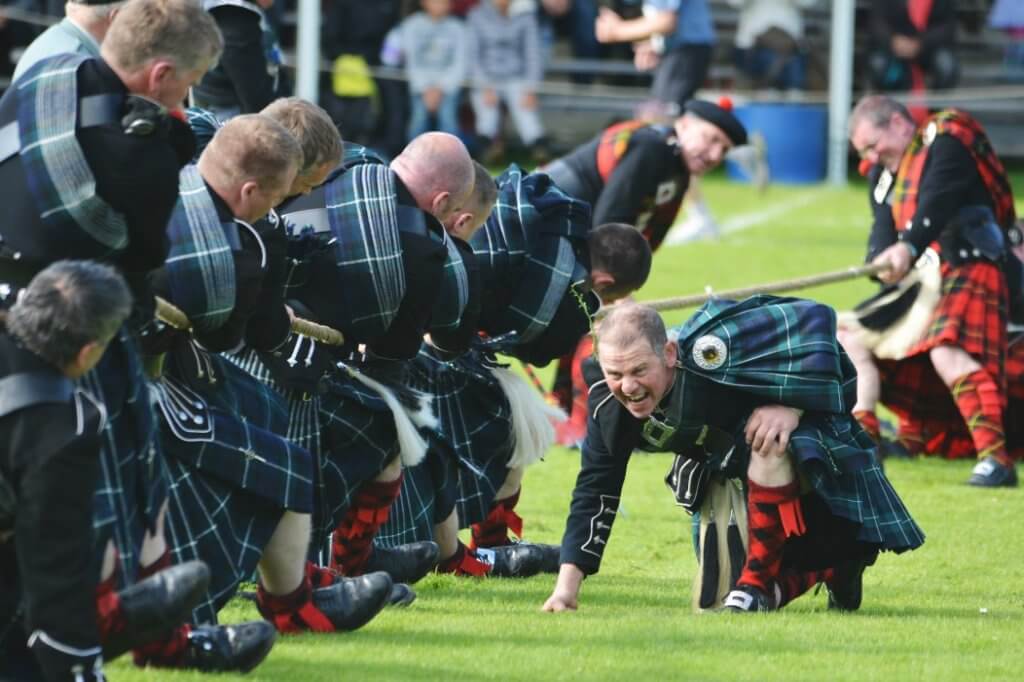
Usually the final event at the Games but always great entertainment
That’s what I think Scotland is most famous for… what do you think?
There are calendars online where you can see lists of dates for all the Highland Games and Gatherings throughout the year. Each one tends to take place on a set date. For example, our closest games (the Abernethy Highland Games), always take place on the 2nd Saturday in August. But if you’re not in the area then, you could always go to Tomintoul, Newtonmore, Braemar or Grantown Games.
The Highland Games are a truly spectacular event. If you do have the chance to attend, it really will be an event to remember. The sound of a mass pipe band is something which will stay for you for a long time and the “heavy” events are properly stunning. Tossing the cabre is uniquely Scottish and we can even boast a local world record holder in the event!
We’ve scheduled our Complete Cairngorms trip in 2025 to run between the Newtonmore Highland Games and the Abernethy Highland Games. When you book the trip, be sure to let us know if you’d like to extend to go to either or both of these events.
What does ‘off the beaten track mean to you’? Depending on how adventurous you are, the phrase can mean different things to different people. It can be scary to choose the path less travelled by, but the benefits from getting off the beaten track in Scotland are exhilarating.
But, this certainly doesn’t mean you need to skip all the top sites like Loch Ness. For some, getting out of cities is rural enough and therefore Loch Ness is a great choice. But for those feeling adventurous and wanting to get a little more remote, we can help you there.
Wanting to find a little peace and quiet is the most natural thing in the world whether you’re most at home surrounded by nature, a city dweller or somewhere in between. And arguably, there is no better place than the Highlands of Scotland. Known for its epic beauty, contrasting scenery and out of this world views, you’ll soon find yourself where the air and water are fresher and the most prominent noises keeping you company is nature at its finest.
The Cairngorm National Park is the ideal base for you to experience and explore the remoteness the Highlands can offer. Depending how far off the beaten track you want to get you’ll find an array of options suited for all fitness levels and ages. Offering options to be guided, or self exploration if you prefer, Scot Mountain Holidays has it all.
We understand that only you know what getting off the beaten track means. But, Scot Mountain Holiday trips, by definition are all off the beaten track. It’s unlikely you’ll see crowds of people during any typical day with us. Choosing one of our trips is a great way to decide if the more unusual spots and a more active vacation is the way forward for you.
Whether you’re after hiking, mountain biking, walking or countryside relaxation, you’ll find it here. We can help organise a tailor-made trip for you, friends and family. Or, you can join one of our scheduled trips where you’ll meet like-minded people and gain friends for life. The choice is yours.
The Cairngorms National Park offers some of the most exhilarating mountain biking experiences in the UK. From expertly designed trail centres to expansive natural trails, the Cairngorms cater to riders of all skill levels. Whether you’re an adrenaline junkie seeking challenging descents or a family looking for a leisurely ride through stunning landscapes, the Cairngorms have something for everyone. Let’s dive into the details of what makes this region a must-visit destination for mountain biking enthusiasts.
The Cairngorms boast several well-developed trail centres that provide a variety of routes and facilities to ensure a fantastic biking experience. Here are some of the top trail centres you shouldn’t miss:
Laggan Wolftrax is a premier trail centre known for its challenging routes and spectacular views. It offers trails ranging from green (easy) to black (expert), ensuring that every rider finds a suitable path. The trails are well-maintained and designed to provide a thrilling ride through the heart of the forest.
There are also some trails across the road where you can explore a hill fort too.
Glenlivet is another top destination for mountain bikers. It features flowing singletrack trails that cater to intermediate and advanced riders. The centre also offers bike hire, a café, and ample parking, making it a convenient and enjoyable stop for bikers.
Glenlivet now have a zip wire development too and are constantly adding and maintaining their tracks. It’s one of our favourite places to go, if we head to a trail centre.

MTB trail riding at Glenlivet, Cairngorms National Park
For those looking to hone their skills, the Grantown Skills Park is the perfect place. It features a variety of obstacles and practice areas where riders can improve their technique. Whether you’re a beginner learning the basics or an experienced rider looking to perfect your jumps and turns, this skills park has something for you.
The Boat of Garten Pump Track is ideal for riders of all ages and skill levels. This compact track is designed to help riders develop their balance and bike handling skills. It’s a great spot for a quick ride or for families to enjoy together.
The pump track is literally on our doorstep. If you’re looking for a wee practise cornering or pumping your bike it’s a great place to go and all the locals are very friendly and hopeful if you’re after some tips.
Tarland Trails offers a mix of trails suitable for all abilities. From flowy singletracks to technical sections, it provides a diverse riding experience. The community-driven development of these trails ensures they are well-maintained and continuously improved.
High Burnside features a network of trails that wind through beautiful woodland. It’s known for its natural feel and varied terrain, offering a great mix of climbs and descents. This trail centre is perfect for those who enjoy riding in a more natural setting.
There are now plans to add a multi-million pound purpose built mountain biking trail centre near Loch Ness, which should complement what’s on offer already.
For those who crave adventure beyond the structured trail centres, the Cairngorms’ natural trails offer virtually unlimited options. You can embark on epic journeys, cycling almost entirely off-road for over 100km in loops from the base in Boat of Garten. Here are some classic routes to consider:
The Burma Road is a challenging route that rewards riders with stunning views of the Cairngorms. This trail features a mix of steep climbs and exhilarating descents, making it a favourite among experienced bikers.
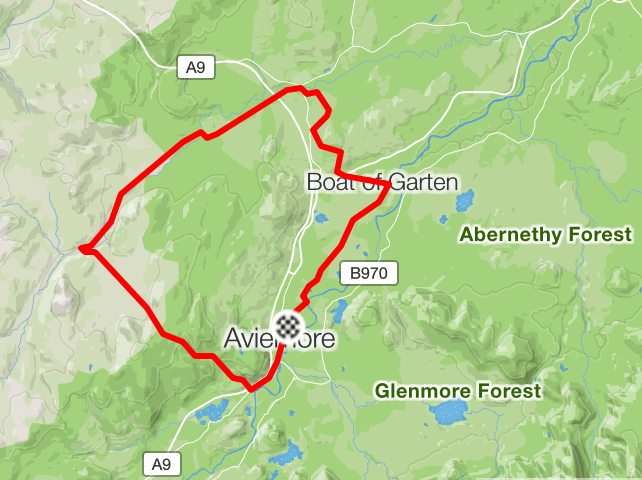
Map of the Burma Road Route.
Gleann Einich is a picturesque route that takes you deep into the heart of the Cairngorms. The trail follows a glacial valley, offering breathtaking scenery and a sense of remote wilderness.
The Abernethy Loop is a diverse trail that takes you through ancient Caledonian pine forests and open moorlands. It’s a fantastic way to experience the varied landscapes of the Cairngorms.
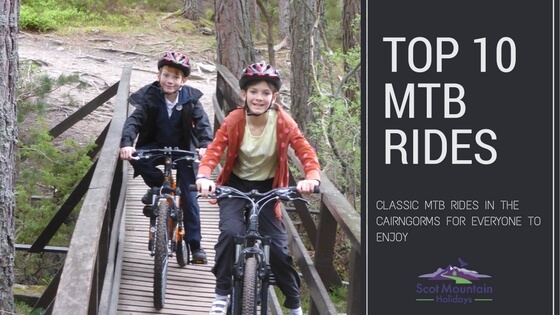
This section of the Cairngorm Circuit is known for its challenging terrain and beautiful vistas. It’s a demanding ride that will test your endurance and technical skills, but the rewards are well worth the effort.
Glenfeshie offers a mix of technical singletrack and scenic forest trails. It’s a lesser-known gem that provides a peaceful and enjoyable ride away from the more crowded areas.
To make the most of your mountain biking adventure in the Cairngorms, it’s essential to have reliable maps. Trailmaps are highly recommended as they provide detailed information on the routes, including difficulty levels, elevation profiles, and points of interest. These maps are invaluable for planning your rides and ensuring you stay on track.
The Cairngorms are a mountain biker’s dream, offering a blend of well-developed trail centres and endless natural trails. Whether you’re seeking the thrill of expertly designed routes or the adventure of exploring rugged landscapes, the Cairngorms have it all. Pack your bike, grab your trail maps, and get ready for an unforgettable mountain biking experience in one of Scotland’s most stunning regions.
COVID and retirement plans have created complete havoc in the cafe market here. Our list of cafes is now seriously outdated and we’ve been forced to revise it completely as when re-reading the list in October 2021, we noticed that at least half of the recommended cafes have now closed. Watch this space over the next week or so and we’ll give you the new improved list.
Graeme McLean of Developing Mountain Biking in Scotland recently described Aviemore to me as having a “cycle culture”. At the time this meant nothing to me, until they went on to explain that when you visit Aviemore you become seduced into cycling just because it seems to be the thing to do. When everyone else seems to be cycling around this must mean that it is the thing to do. Hence in our area it is not difficult to come up with a list of cyclist friendly cafes.
Certainly here at Fraoch Lodge we have noticed a definite increase in the number of people driving around the area with bikes mounted on the car and also a definite increase of bike use on the tracks.
These are the cafes we are most familiar with and are therefore almost all on the north side of the Cairngorms, in and around Aviemore. However, we will be in Deeside for a week in July and will be very happy to update our list after 16th July with some additions from Braemar, Ballater etc – if we find anything which meets our criteria: superb food (especially cakes), somewhere to safely leave your bike locked, somewhere to work on your bike, bike/cycling route advice, bike/cycling related reading materials, maps for sale.
After consultation with my fellow members of Petal Power (the Cairngorms area female mountain biking group), I’ve come up with the following list.
Listed in order of their proximity to Fraoch Lodge:
The Osprey Coffee House has come on in leaps and bounds since it re-opened after Covid. It is now owned and managed by Andreas and Tanya Perch. The Perches have plenty of Coffee Shop experience having previously run their own enterprise in Val d’Isere (French Alps). They offer soup as well as “Fika” (coffee and cake, Swedish style).
Routes close by: Speyside Way, Burma Road, Ryvoan Pass plus numerous local routes through the woods, Woodland Wheels (Boat of Garten pump track)
Unfortunately Nethy House is currently up for sale but it is a highlight of any route in the area. They get any meat they need for their lunch options from Balliefurth Farm Shop next door (the highest quality of meat). Cairngorms Connect venison is also available through the butchers at the farm shop. If you eat meat, certainly make the time to fit in a visit.
Routes nearby: Speyside Way, Abernethy Forest, Forest Lodge, Ryvoan Pass, plenty of forest routes and Rynettin also a highlight
Delicious smells were emanating from the door when I went by to take a peek at the menu. Great selection of hot food. The Cullen Skink is exceptional and the cakes are very hard to resist, especially the cheesecake.
Recommended by Petal Power
Routes nearby: Burma Road, Tomatin on Route 7, off road route to Boat of Garten via Route 7
Despite it’s proxmity to Mike’s Bikes, I have yet to sample the delights of Ryvoan Cafe personally, but I have had universally good reports from friends who have been there.
Under the personal supervision of owners, Nina and Daniel, Ryvoan Cafe isn’t just Aviemore’s latest neighbourhood deli-cafe – they’re passionate about creating a warm and inviting space where you can unwind and indulge.
“Our menus are carefully crafted to delight your palate with simplicity and finesse. We embrace the ever-changing seasons, incorporating locally sourced ingredients for an authentic and memorable dining experience. From sophisticated snacks and charcuterie to be shared, perfectly complemented by our selection of organic wines, to drinks and dining that draw visitors from far and wide.”
Routes close by: Rothiemurchus estate, Lairig Ghru, Glen Feshie and Glenmore to Inshriach
(Petal Power comments) Inschriach Nursery Cafe have always been very welcoming, even when wet and muddy.
The Barn does take away cake etc as well as eat in. There is usually plenty of choice and there is the Rothiemurchus shop just across the car park if you’re looking for any treats to take home. Meat from the estate is also sold there.
Routes nearby: Burma Road, Loch an Eilean, Rothiemurchus estate, Speyside Way, Badenoch Way, Glenn Einich
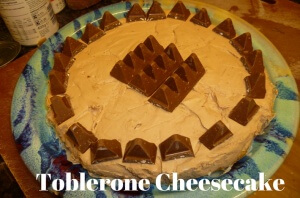 Plenty of imaginative cake options at the Mountain Cafe. This particular cake is one of ours but the Mountain Cafe has spectacular offerings too.
Plenty of imaginative cake options at the Mountain Cafe. This particular cake is one of ours but the Mountain Cafe has spectacular offerings too.Another popular spot right next to Glenmore campsite and very convenient if you’re looping around Loch Morlich or more widely through Rothiemurchus estate or the Ryvoan pass. They have a bar but also do a roaring trade in coffee, hot chocolate and hot food plus they have a wee shop attached if you just want a snack. If you’re lucky enough to be out for a late ride you might even catch some of the live entertainment.
Routes nearby: Ryvoan pass, Glenmore Forest Park, Loch Morlich
One of my favourite places to stop if I’m ever over this way. I just love the atmosphere and Tony himself (owner and front of house) is a keen cyclist too. They go the extra mile for cyclists for sure. There isn’t a massively extensive menu but everything they offer is top quality and reflects their Italian heritage. Ann Vastano (co-owner of the cafe) is a renowned local artist who sells prints and cards of her work, alongside the orginals displayed in the cafe.
Being a purpose built MTB centre, the Coffee Still at Glenlivet ticks all the best practice boxes. Currently run by the owners of Nethy House. There are bike racks, wee track to keep the kids happy, trail maps for sale, bike hire available, range of food – not only cakes but hot food like pizza and burgers too. The trails are great too and very family friendly.
Routes nearby: Glenlivet MTB trails, Glenlivet Distillery routes, Kinkardine Hills, Ladder Hills
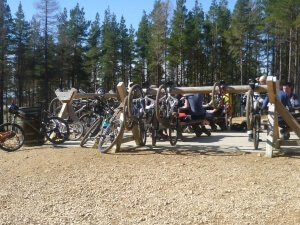 The Coffee Still at Glenlivet MTB trails – right next to a wee practice track which keeps the kids occupied while waiting for your order to arrive.
The Coffee Still at Glenlivet MTB trails – right next to a wee practice track which keeps the kids occupied while waiting for your order to arrive.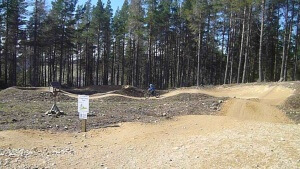 Humps and Bumps to keep the kids keen while the food is being cooked in true Slow Food tradition from the best of local ingredients. (Glenlivet MTB Trails)
Humps and Bumps to keep the kids keen while the food is being cooked in true Slow Food tradition from the best of local ingredients. (Glenlivet MTB Trails)
Not forgetting the south side of the park (nominated by Petal Power, an all-female mountain biking club in the Cairngorms, centred around Aviemore and Nethybridge)
The Bothy is an excellent relaxing spot attached to Braemar Mountain Sports. Bikes can be hired here and the back of the cafe looks out over the river. The cakes and hot chocolate also deserve some praise. Plenty of choice at the cake bar.
Honorary mentions nearby the Cairngorms
Linda, who runs the Pottery cafe and bunkhouse, has been baking bread and cake for more years than she cares to count. Her cakes are always light and the soup is delicious. The cafe is a hop-skip-and-a-jump from Laggan Wolftrax and though I haven’t eaten at Laggan so I can’t compare the two – Linda’s opening hours were longer and she’s open all year round. When I was at Laggan (before the main season opened) the cafe was closed.
Routes nearby: Laggan Wolftrax
2. Olive Tree Cafe (Logie Steading) – on the Dava Way, just outside Forres
Logie Steading is a collection of up-market operators selling all kinds of things from second-hand books to plants to pictures and not forgetting food. You can also catch up with
From the Daily Record: Top cycle friendly cafes in Scotland
http://www.skinnytyres.com/2010/10/14/great-cycling-cafes-is-scotland/
4o
In Scotland we are far enough north that our hours of daylight vary considerably with the seasons. Our guests often comment about the length of the day in summer and speculate about how we cope with the short winter days.
21st December – the winter solstice is technically the shortest day of the year. Practically speaking though, any day around that time of year will feel like the shortest day if it is pretty driech whereas if 21st December is a bright, sunny day it might not seem all that short in comparison.
December, being the month of the winter solstice, witnesses the shortest day of the year. Around December 21st, the winter solstice, Scotland experiences its minimal daylight hours. In Edinburgh, the capital city located at 55.95 degrees north, daylight lasts approximately 6 hours and 57 minutes on the shortest day. The sun typically rises around 8:42 AM and sets at 3:39 PM.
Traveling further north to Inverness, which sits at 57.48 degrees north, daylight decreases slightly more. Here, the sun rises around 8:55 AM and sets by 3:33 PM, giving just over 6 and a half hours of daylight. It feels like a lot less than this if it’s not a sunny day! There are days in winter when you feel like you need the lights on all day.
The further north you are, the longer it takes for true darkness to arrive after sundown. In the northern isles of Scotland, such as the Shetland and Orkney Islands, the daylight during the summer solstice stretches even longer. Lerwick, the largest town in the Shetland Islands at 60.15 degrees north, experiences sunrise around 3:38 AM and sunset at 10:34 PM, offering about 19 hours of daylight. The twilight here is so prolonged that the sky never fully darkens, creating a phenomenon known as “simmer dim” – a perpetual twilight that bathes the landscape in a soft, ethereal glow.
21st June is the summer solstice when technically we have the shortest night of the year and therefore the longest day. In Inverness, situated at 57.48 degrees north, the sun rises around 4:14 AM and sets at 10:19 PM, providing nearly 18 hours and 5 minutes of daylight. This extended daylight is a hallmark of Scotland’s northern regions, where the sun barely dips below the horizon.
The extended daylight hours of the summer solstice are celebrated across Scotland. Festivals, outdoor events, and various activities are scheduled to take full advantage of the long days. From exploring ancient castles and hiking the Highlands to enjoying coastal walks and partaking in traditional Scottish festivals, the opportunities are endless.
Residents and visitors alike adjust their routines to make the most of the daylight. Late evening walks, barbecues, and social gatherings become common as people revel in the extended light. This period is also ideal for photography, as the prolonged golden hours provide exceptional lighting for capturing Scotland’s stunning landscapes.
In the far north, near the Arctic Circle, the experience of the summer solstice can be particularly unique. The Orkney Islands, for instance, not only enjoy extended daylight but also host cultural events that celebrate the solstice. The St Magnus International Festival in Orkney is a renowned arts festival held around the time of the solstice, featuring music, theater, and dance, all set against the backdrop of nearly continuous daylight.
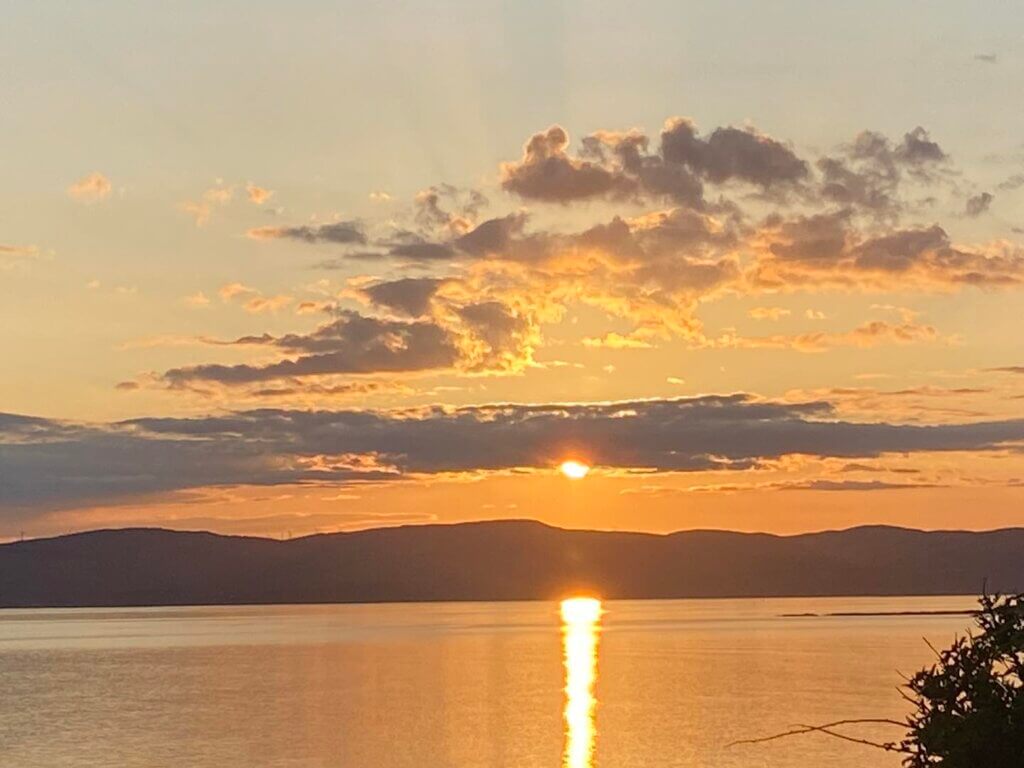
Short days, dark nights – what are the advantages?
The aurora are only visible in dark skies so the best time of year to see the Northern Lights in Scotland is the autumn and winter months.
The brief daylight hours in Scotland during winter can impact daily routines and activities. Residents often make the most of the available light, adjusting work and leisure schedules to fit the limited daylight. Many embrace the long evenings by indulging in indoor activities, such as enjoying the warmth of a fire, reading, or engaging in traditional Scottish pastimes. It’s the ideal time to get your knitting needles or crochet hooks out and get creative with yarn.
Visitors to Scotland during the winter months should plan their activities accordingly. Sightseeing is best done during the middle of the day, and early sunsets provide an excellent opportunity to experience Scotland’s vibrant nightlife, cozy pubs, and cultural events.
Despite the limited daylight, Scotland’s winter landscape holds a special charm. The low angle of the sun creates a unique, soft light that enhances the natural beauty of the scenery. Frosty mornings, snow-dusted hills, and the chance of witnessing the Northern Lights make winter a magical time to experience Scotland.

Metcheck – chart of sunrise time, sunset time and hours of daylight per day.
Scotland.info – scotland weather and climate
Pros and Cons of each season in Scotland
Hiking with kids is not always a fun experience but our top tips could change that around for you. Boat of Garten, Scotland is rich in natural beauty. Its rural setting lends itself to plenty of hiking opportunities for not only individuals, but also families.
So, if you’re looking to go hiking with your kids around Boat of Garten, here are 8 great tips on how to make the best of your trip:
“Every hiking trip has to be planned and prepped for,” says Madeleine Walder, a travel blogger at State of writing and Essay Roo. “This is especially important when you bring your kids along for the trip. You’ll need to plan your day with the kids in mind – when they’ll be energetic, when they’ll get tired, and so on.”
Here are things you’ll need to pack for everyone in the family:
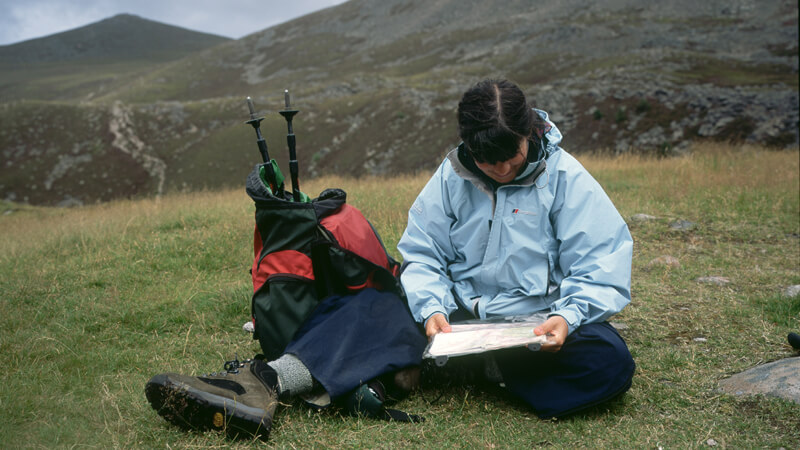
A female walker seen sitting down resting and studying her map, wearing her boots and waterproof clothing, with her rucksack and walking poles, Cairngorm Mountains, Scotland.
Model Release
Photograph by David Mansell 07831 559901 mobile
2. Dress Accordingly
Next, it’s important to dress for the trip. Consider the following scenarios:
However, no matter the hiking weather, be sure to have the right clothing, including:
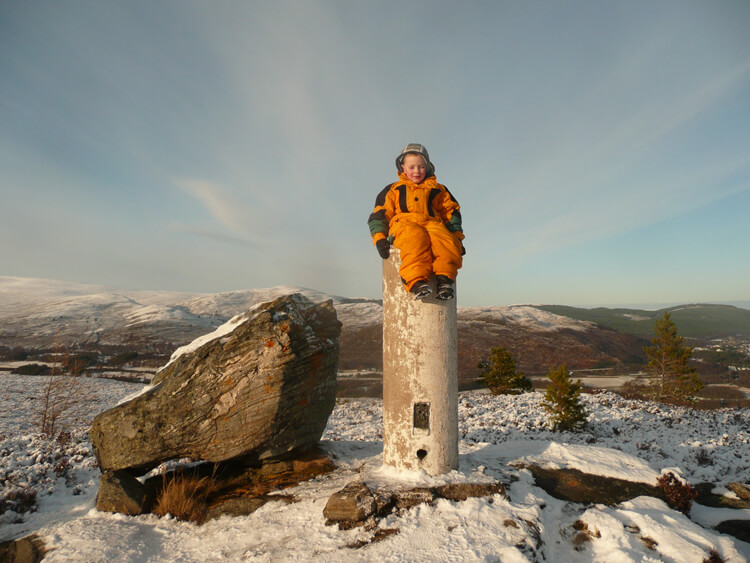
Spring is a great time to get the kids out hiking. There’s still snow to play in but it’s not as bitterly cold as winter.
3. Choose Varying Trails And Terrains
Children love to explore. So, when choosing a trail, look for the following features:
For example, Frank Bruce’s Sculpture trail at Insh; Gruffalo walk in Culloden Woods; Boat of Garten to Loch Garten – plenty of fallen trees to explore as it is the RSPB policy to leave fallen wood where it lies for the other forest beasties to benefit from.
Who knows? Your kids will come up with great adventure ideas when they’re on the hike. With wild imaginations, anything is possible for kids.
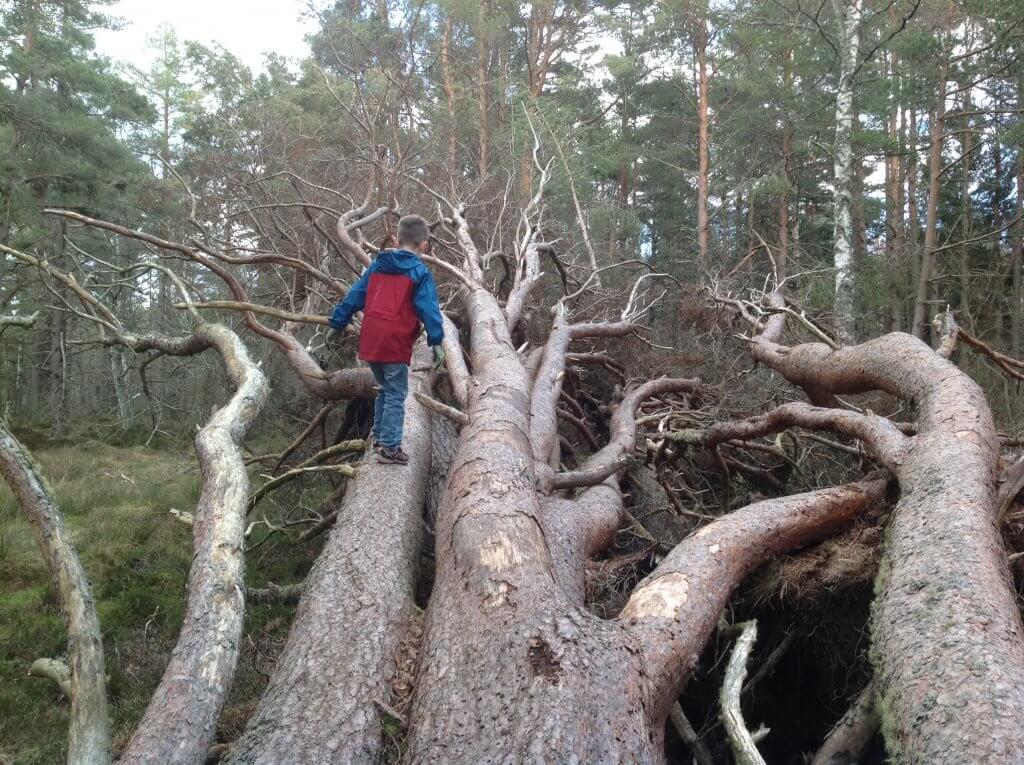
What fun teetering along the trunk of a fallen tree.
4. Invite Friends
Why hike by yourselves, when you can take friends along for the trip?
Kids might have friends that they want to invite to the trip. So, feel free to let them invite friends over for the trip. Just make sure that your child’s friend(s) are well-prepared for the trip.
If you have a dog, then you can let them join your trip as well! But again, everyone (including Fido) will need to be prepped for the trip.
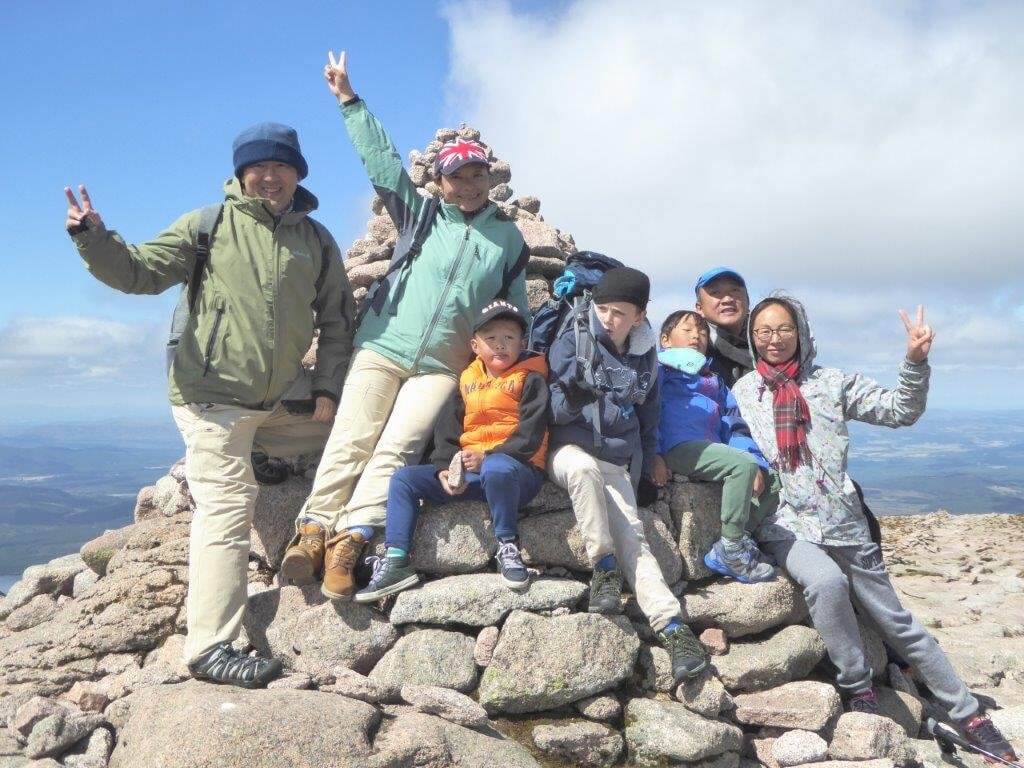
5. Take Breaks
It’s natural for people to take breaks. Now, with kids, they’ll need to take plenty of breaks, especially when they’re hiking. Even if they start complaining that they’re not tired just yet, you’ll still need to have them break.
On the other hand, kids will complain about being tired. Again, that’s why it’s important to plan for frequent stops.
Now, when you and the family stop for a break, don’t just sit down somewhere. Also, make sure that everyone “refuels,” meaning that you all take in some food and drink before continuing the hike. A snack favorite for kids is a medley of snacks, including trail mix. Wild food/foraging could become a new favourite if you’re out at the right time in the right place.
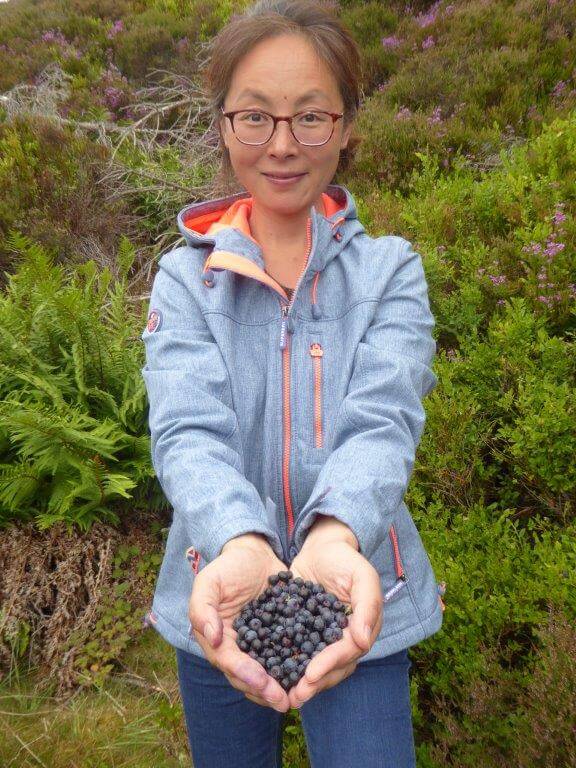
6. Be Positive
Hiking is about enjoying yourself. Although your kids might whine about something along the way, why not spin it around with fun questions like:
The idea of asking questions is to keep your child engaged, and to prevent them from feeling bored or sad.
Also, treat your child with respect. If your child is visibly tired after a while, then it’s time to go home.
7. Take It Easy
“When hiking with your kids, it’s okay to relax,” says Cameron O’Neill, a lifestyle writer at Lia Help and Boomessays. “Try not to think about the time passing by, when you don’t have anything else planned for the day. Focus on hiking with the family. Focus on taking in nature, and enjoying it with your kids. Remember: There’s no hurry. Take your time. Take it easy.”
8. Make Hiking A Family Tradition
Family traditions create memories that last a lifetime. So, why not make hiking a family tradition?
Whether you and the family take hiking trips monthly or yearly, this family tradition is for you to create. This family tradition also allows children to embrace nature as much as possible.
Conclusion
As you can see, hiking in Boat of Garten, Scotland can be a fun experience for you and your child. Therefore, take these 8 tips, and have fun (and be safe) hiking with the family!
If you’re looking for more help and advice planning your walks in the Cairngorms, or if you’d like to try one of our ready-made itineraries please get in touch.
Top tip from Scot Mountain Holidays: Experience has also taught us that having animals along on the walk helps to motivate the kids to keep going. This was particularly the case when we were persuaded to try Trekking with a Donkey in France. We then took that experience to develop our own version into the Highland Wilderness Glamping Adventure – to create memories which will last a lifetime.
Elizabeth Hines is a writer and editor at UK Writings and Academized. She is also a contributing writer for Write my paper. As a content marketer, she writes articles about latest tech and marketing trends, innovations, and strategies.
“It’s all in the Wood” – or how to choose great malt whisky
Adventure Guide Andy Bateman of Scot Mountain Holidays guides you through the mist of romance and hype, and around the pitfalls in choosing a fine bottle of malt whisky.
Scottish Malt Whisky is simply not Scotch unless it’s been matured in an oak cask. Up until this point it is just spirit from the still. Essentially a mix of alcohol & water plus e.g. elements of smoke should the barley been dried over a peat fire.
A complex interaction between the oak and the spirit takes place during maturation with the alcohol drawing out many of the oils and other components of the wood. It’s the presence of these oils that gives the whisky’s depth of flavour and breadth of character. This is what Malt Whisky is so let’s look at ‘journey” these oils take during the whisky making process.
Quality of the Wood – are the oils still present?
Firstly, if there isn’t quality in the wood you won’t get the quality in the whisky. The oak casks are used a number of times and with each maturation, oils are removed from the wood. If you mature spirit in an exhausted cask, it doesn’t matter how long it slumbers, the whisky will lack quality. The two questions that need to be asked are:
How many times the cask has been used previously?
The majority of Scotch Malt Whisky is matured in ex-American Bourbon casks. This first maturation of Bourbon removes the harsher notes from the new oak. After the subsequent 1st and 2nd maturations of Scotch Malt whisky the wood starts to loose it’s quality. Up to 60% of the vital ingredients can be drawn out during the first maturation with the whisky produced from 3rd and subsequent maturations often being of a lower standard.
Malt whisky production is a batch process and each cask has its own individual characteristics depending on a range of factors. The world of single cask malt whisky is infinitely varied. For the malt marketeer this has traditionally presented a problem of consistency. Understandably when you find a whisky you like, you want to know that the next bottle will taste the same. This is where the Master Blender (aka “The Big Nose”) comes in. They will marry together up to 100 casks from the same distillery to produce a consistent single malt*. Some of these will be good 1st or 2nd refill casks, others will be the not-so-good 3rd or 4th generation.
* A blended whisky is a mixture of malt whiskies from different distilleries and grain whisky.
has the spirit had enough time to draw the oils out of the wood?
The traditional length of time that the spirit needs to mature is an issue for the industry. Due to demand there has been a recent tendency to downplay the importance of the age. Traditionally it was around 10 years or more. Some have partly got around it by decreasing the cask size to increase the wood to spirit ratio and hence shorten the maturation period. Laphroaig’s Quarter Cask expression being a prime example. There are some good young single malts but this is not to infer the maturation period is not a very important part of the process. It takes time for the oils to be drawn out of the wood. The harsher flavours are softened over time and so the age is an important factor in the quality of the final product.
Scotch Whisky is matured in the cask above 60% ABV i.e. “Cask strength”. The market for Cask Strength whisky is small and most people who enjoy a tipple find it too strong. Diluting cask strength whisky down to the industry agreed standard of around 40% abv greatly improves the marketability through reducing the price as well as improving the palate.
The problem now is the equilibrium that established itself in the cask is altered and there is now no longer a high enough concentration of alcohol to support the oils. There is a tendency to for the whisky to go hazy.
To overcome this problem the long chain oils in most commercial malt whisky are removed by chill filtering but it is these longer chain oils that give the whisky it’s depth of flavours and breadth of “character”. The chill filtering also removes some of the variability and makes the Master Blenders job a little easier in creating that brand flavour.
A large number of commercial malt whiskies are coloured with the addition of Caramel. This also affects the flavour of the whisky.
Distilleries are often produce casks which don’t fit in with the taste profiles they wish to create and are happy to sell these on to Independent Bottlers. It’s through these companies that you often get some of the best whisky at a good price.
Check out hiking holidays incorporating Whisky : Walking, Whisky & Wildlife or Mountains and Malts
Recommended distillery tours from Fraoch Lodge: Aberlour, Glenlivet, Glenfiddich. You could also try our self-guided whisky story tour, based from Fraoch Lodge
OK – we thought we’d have a little fun with this blog and give you a few silly tips along side the more serious suggestions.
It’s Scotland – there weather is always unpredictable, but as they say – there’s no such thing as bad weather, just inappropriate clothing and I can vouch for that personally.
Ne’er cast a cloot till May’s out. what it actually means is, don’t take off your winter clothing until May is over!
80% of mountain rescue callouts stem from navigational errors. We know that there are mulitpe mapping apps available to help when you’re in the great outdoors – OS maps; Komoot, Outdoor Navigator to mention just a few; or Walk Highlands too if you’re looking for one specific to our area. But these all depend on your phone having good battery power; or you having packed a spare battery to back up your phone.
It is always best, especially if you’re in an area of poor phone reception, to carry a map and compass (so long as you have the skill set to use them effectively). If you do plan to walk on your own it’s probably best to make sure you have some basic navigation skills, before you head out the first time and use your phone as a back up rather than your primary navigation tool.
Further navigation reading:
Winter Navigation and its perils

Photo by David Mansell
Travel backpacks and school bags have their place, but if you are intending to walk/hike for any length of time (i.e. over 3 hours) you probably want to consider investing in a bag which has a capacity of at least 30 litres and an adjustable strap system. It is extremely important for your comfort, that the bag is adjusted properly for you. If you don’t have a friend who is able to help when you go to choose a backpack; the staff in the shop are usually trained to help.
If you intend to climb, the length of the back system could be very important as the last thing you want while you’re climbing is for your backpack to be hitting the back of your helmet and impeding your vision. This is more likely to be an issue if you are less than 160cm tall.

Strange as it may seem to some, sunscreen is important even in Scotland. Our days in summer can be very long which means that you could be out in the sun for more hours than you anticipate and there is often very little shade when you’re high in the hills.
The most commonly available midge repellent is Smidge but there are more and more products coming on to the market which are more enrionmentally friendly and good to your skin. Highland Soaps produce a skin cream scented with bog myrtle. Bog myrtle grows wild in the Highlands and naturally repels midges.
There’s also another natural brand called Beastie Be Gone which you might want to investigate.
Only really necessary as a camping addition. If you’re not planning to stop for long then a midge net will probably not be necessary. Also bear in mind that if you are in a windy situation then you won’t encounter any midges anyway as they can not cope with any more than a light breeze.
This might be something which lives in the bottom of your backpack and never gets used – but that’s a good thing. If you’re hiking with a guide, you probaby won’t need one either as the guide will carry one as a matter of course for the safety of the group.
A portable/emergency shelter is not necessarily just for emergencies but can provide you with a wind break when you need to take a break to eat or whatever.
Seriously? Yes, there are occasions when it isn’t windy and cold!
You’ll find that you’ll get conflicting advice on using poles, depending on who you speak to. My father is against them; I use mine all the time. They are very useful for river/stream crossings; to help with your balance.
If you check out the photo below though, the vote seems to be in favour of poles when hiking here in the Highlands.

Possibly the most useful thing to have in your first aid kit. It’s probably worth adjusting your first aid kit if you’ve bought a premade kit. It’s unlikely that you’ll need a huge number of field dressings or slings, but more than likely that you’ll need a stock of compeed for blisters, tweezers (to deal with splinters) , possibly some rehydration tablets and paracetamol.
You can buy commercial versions but the most satisfying will probably be one that you make up yourself if you have time. We like a home made grain free granola mix. Recipe here.
There’s no chocolate in this particular version but there are plenty of options which contain chocolate: eg white chocolate, cranberry and pistachio.
You could also make a more savoury version or experiment with a high protein mix, depending on what suits your preferences.
Always a good option here in Scotland where you can easily have 4 seasons in one day. Also shorts are not always a good idea if you’re going to be brushing past any undergrowth as you’ll need to be aware of ticks.
Unfortunately even in what you might consider to be the height of summer (July and August) it can be extremely cold on the mountain tops and it’s not unknown for snow flakes to fall!
You might not need the thickest winter gloves in the middle of the summer season but the wind can pick up at any time and particularly if you’re using poles your hands can be exposed and cool off quite quickly.
Wool is worth investing in particularly if you’re going to be hiking for more than one day. It doesn’t smell as quickly as artificial fibres; it breathes and it will be warm even if damp.
If you’re hiking any time from April to August, the daylight hours will likely be long enough that you might think that you don’t need a torch, but it is a useful piece of kit to have in your bag in case you take a wrong turn or decide to be out longer than you originally planned.
Always a good idea to add a waterproof lining to your bag, even if you have a rucksack cover. Unfortunately rucksack covers can blow off your pack quite easily and then inevitably water will ingress.
This might seem like an obvious one, but you’d be amazed how many people show up without water bottles for one of our planned hikes. Some kind of reuseable water bottle is always best rather than bottled water from the shops.
A thermos can be used to keep drinks both hot and cold so don’t ignore the opportunity to carry a thermos in the summer.
We’ve covered quite a bit here and you can obviously take all under advisement as the heavier your bag the less likely you are to enjoy the day. It is a balance between weight and what you need to be comfortable throughout the day.
Enjoy!

Playing with lichen
All content © Copyright Scot Mountain Holidays 2024
Responsive web design by Summit Web Solutions